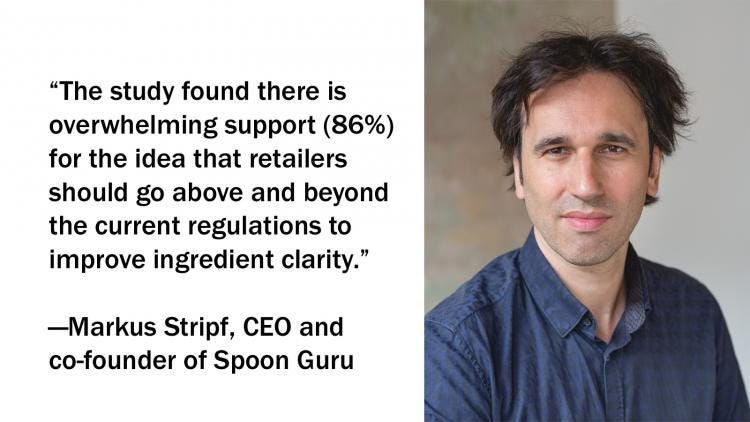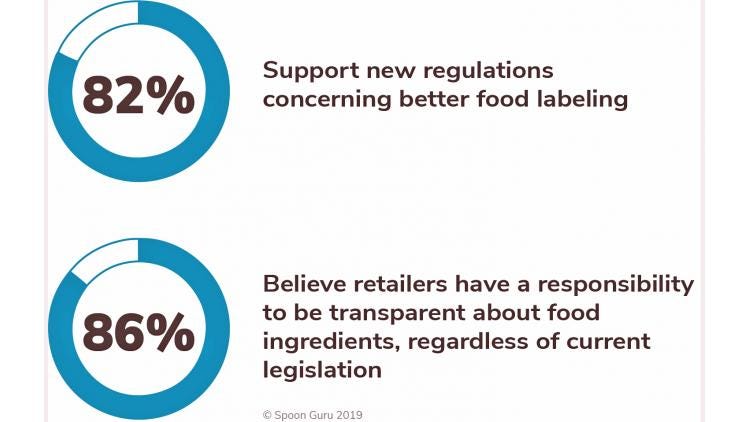January 31, 2019

A new study from consultancy Spoon Guru found lack of clarity and information for food allergens on food products and packaging was a serious problem—and it offers solutions in this exclusive interview.
It’s said that two-thirds of the world’s population intentionally excludes certain foodstuffs from their diet due to health concerns or choices, which means the food industry is under mounting pressure to meet growing consumer demand for tailored food choices. A new study commissioned by Spoon Guru to look into the related struggles for this nearer to home stateside found that U.S. consumers who have food allergies, intolerances or lifestyle diets yielded some troubling results. One of those surprises among the 2,000 consumers surveyed was that 33% of Americans have accidentally purchased on a weekly basis food that does not align to their dietary requirements do so; and some 49% of them said that was due to poor labelling information.
Other findings:
The data found Americans aged between 25 and 44 who have some form of exclusion diet struggle the most when shopping for foods at supermarkets or online;
The worst affected were Vegans, with 45% saying they suffer the most from vague or non-existent ingredients labeling when trying to find the right food;
In analyzing how female consumers fair versus males, the data revealed that a third (34%) of men made errors when there was no product labels whereas only a quarter of females (25%) made the same mistake;
82% of those surveyed support new regulations concerning better food labeling.

“With an increase of U.S. consumers adopting exclusion diets, whether due to an allergy or intolerance or simply just a lifestyle choice, there is a clear need to make food discovery much more inclusive,” said Markus Stripf, CEO and co-founder of Spoon Guru. “The study found there is overwhelming support (86%) for the idea that retailers should go above and beyond the current regulations to improve ingredient clarity, and the general feeling among U.S. consumers is for on-trade and off-trade retailers to take more accountability where food labeling is concerned.”
Packaging Digest’s sought Stripf’s insights and advice regarding the survey findings.
Let’s start with an overview of what Spoon Guru is about.
Stripf: Established in 2015, Spoon Guru is a London-based technology start-up that developed a unique food search and discovery engine to cater for individuals with multiple or complex search requirements: the Spoon Guru TAGS platform. It enables food businesses to deliver a highly personalized experience tailored to each consumer, based on their distinct and unique dietary needs—increasing the choice of foods available, while minimizing the effort to find them. It does this by combining Artificial intelligence, machine learning and nutritional domain expertise, enabling large and unstructured data sets to be easily searched and accurately filtered to deliver relevant choices.
For example, in the United Kingdom, we provide Tesco, the UK’s largest supermarket, with Artificial Intelligence software that helps consumers shopping online find products right for them.
While Spoon Guru is focused on packaged foods and fresh produce, for this study the firm also asked consumers about dining experiences related to their dietary restrictions.
How is it that legal requirements have not addressed this—what causes the gap in awareness and information that’s at the core of the problem?
Stripf: By law, packaged foods need to disclose if any of eight major allergens are included in the product that include milk, egg, fish, crustacean shell fish, tree nuts, wheat, peanuts and soybeans. However, these eight allergens only cover a small amount of food allergies and if you are on a lifestyle or health-specific diet they won't help you much. Also, eating out poses even bigger challenges as it is even harder for consumers to identify suitable dishes on restaurant menus and waiter error, for example, can cause people to eat foods that are not compatible with their diets.

What were the sources of the errors?
Stripf: These consumers said it happened because:
Human Error i.e., a waiter's fault 52%;
Human error i.e., their own fault 38%;
No labeling at all 29%;
Poor ingredients labeling 37%;
I don't know or I can't remember 5%;
Other 2%.
How do brands address the dilemma of adding more information to tight on-package real-estate?
Stripf: That's a real problem. By working with retailers, digital-shelf edge technology could be used to display additional information for consumers who need to find out more about all the ingredients and a product's suitability. Another solution would be Quick Response (QR) codes that redirect consumers to a resource that contains additional information.
Lastly, what are best practices that brands can use to proactively address this problem?
Stripf: The survey indicated that 76% of U.S. consumers believe technology will play a key role in improving food ingredient transparency. I would suggest is that companies leverage digital technologies so people can check whether products conform to their requirements; for example, using QR codes as mentioned. Other suggestions:
Standardize the language to make it easier for people to quickly ascertain whether something is suitable;
Potentially reformulate to extend your reach (vegetarian products for example could be made vegan);
Drive awareness—if you by the nature of the product you have produced Vegan, gluten-free, nut-free products, etc., let the market know about it;
Work with allergy organizations like FARE and FAACT to understand the biggest hurdles allergy sufferers face and be proactive about making it easier and safer for them.
For more information visit Spoon Guru
You May Also Like


